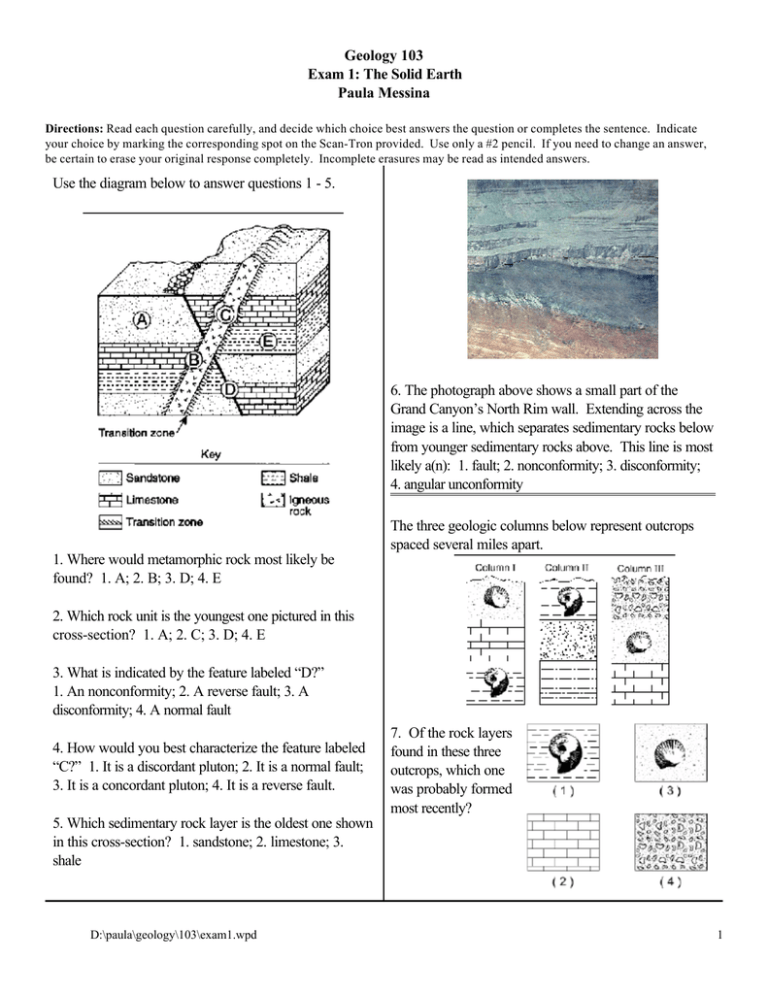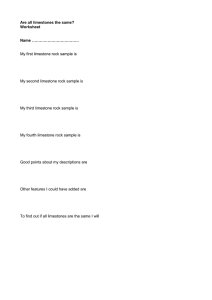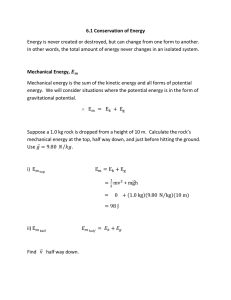Geology Exam 1: The Solid Earth
advertisement

Geology 103 Exam 1: The Solid Earth Paula Messina Directions: Read each question carefully, and decide which choice best answers the question or completes the sentence. Indicate your choice by marking the corresponding spot on the Scan-Tron provided. Use only a #2 pencil. If you need to change an answer, be certain to erase your original response completely. Incomplete erasures may be read as intended answers. Use the diagram below to answer questions 1 - 5. 6. The photograph above shows a small part of the Grand Canyon’s North Rim wall. Extending across the image is a line, which separates sedimentary rocks below from younger sedimentary rocks above. This line is most likely a(n): 1. fault; 2. nonconformity; 3. disconformity; 4. angular unconformity The three geologic columns below represent outcrops spaced several miles apart. 1. Where would metamorphic rock most likely be found? 1. A; 2. B; 3. D; 4. E 2. Which rock unit is the youngest one pictured in this cross-section? 1. A; 2. C; 3. D; 4. E 3. What is indicated by the feature labeled “D?” 1. An nonconformity; 2. A reverse fault; 3. A disconformity; 4. A normal fault 4. How would you best characterize the feature labeled “C?” 1. It is a discordant pluton; 2. It is a normal fault; 3. It is a concordant pluton; 4. It is a reverse fault. 7. Of the rock layers found in these three outcrops, which one was probably formed most recently? 5. Which sedimentary rock layer is the oldest one shown in this cross-section? 1. sandstone; 2. limestone; 3. shale D:\paula\geology\103\exam1.wpd 1 The diagrams below represent four widely-spaced outcrops. 8. Which fossil appears to be the best index fossil? 9. A typical strontium atom has 38 protons, 49 neutrons, and 38 electrons. What might an isotope of strontium contain? 1. 38 protons, 49 neutrons, and 49 electrons 2. 52 protons, 49 neutrons, and 38 electrons 3. 49 protons, 49 neutrons, and 49 electrons 4. 38 protons, 52 neutrons, and 38 electrons 10. A radioactive element, known as “Messinium,” decays into a stable substance known as “Brooklynium.” The half-life of Messinium is 880 years. If an object contains 14 grams of Brooklynium and 2 grams of Messinium, how old is the specimen? 1. 880 years old; 2. 1760 years old; 3. 2640 years old; 4. 3520 years old 11. The major divisions of geologic time known as “eras” (i.e., Cenozoic, Mesozoic, Paleozoic, PreCambrian): 1. are based on major changes in the fossil record; 2. are equal in duration; 3. are split into sub-units known as “horizons”; 4. span the total amount of time that our universe has been in existence. 12. Which of the following lists of geologic periods is in the correct chronological order, from oldest to youngest? 1. Cambrian, Triassic, Silurian, Permian 2. Cretaceous, Ordovician, Carboniferous, Triassic 3. Pennsylvanian, Mississippian, Permian, Silurian 4. Devonian, Permian, Jurassic, Tertiary D:\paula\geology\103\exam1.wpd 1 3. A A b B o v C e is D a cr o E ss s ection of rocks. A, B, C, and D are sedimentary layers that have not been overturned; E is an igneous intrusion that has altered the lower zone of rock D on contact. Which of the following statements regarding the limitations of relative dating of the rock layers is most accurate? 1. We cannot infer whether rock A is older or younger than rock B; 2. We cannot infer whether rock E is older or younger than rock C; 3. We cannot infer whether rock E is older or younger than rock D; 4. We cannot infer whether the line between rocks D and E is a disconformity or a nonconformity. 14. Which one of the following descriptors concerning minerals is not true? 1. solid; 2. definite chemical structure; 3. organic; 4. formed of atoms 15. In what way are diamond and graphite different from one another? 1. Graphite is a mineral, but diamond is a rock; 2. Diamond can scratch any other substance, while graphite can be scratched by many other substances; 3. Diamond has a black “streak” but graphite has a white “streak; 4. Diamond and graphite have different chemical compositions. 16. The most abundant elements found in Earth’s crust are silicon and oxygen. It is no surprise, therefore, that the most common mineral group is the: 1. carbonates; 2.oxides; 3. native metals; 4. silicates. 2 17. Which of the following graphics below best illustrates an intrusive igneous rock? 20. Which processes would form the rock type represented by circle B? 1. deposition and compaction; 2. weathering and erosion; 3. melting and solidification; 4. folding and faulting. 21. Which of the following rocks could be found in Circle C? 1. marble; 2. basalt; 3. shale; 4. diorite 22. Which rocks could be represented by circles x, y, and z? 1. sandstone, conglomerate, siltstone; 2. coal, slate, schist; 3. breccia, gneiss, rhyolite; 4. a’a, pahoehoe, pyroclastics. 23. The classification of rocks into the categories Sedimentary vs. Non-sedimentary is based primarily on the rocks’ 1. origin; 2. density; 3. color; 4. age 18. You find a rock that has a fine-grained composition. Looking at it carefully, you see what appears to be clam shell fragments in it. This rock is most likely: 1.intrusive igneous; 2. extrusive igneous 3. sedimentary; 4. metamorphic 19. For magma to become lava, it has to: 1. come to the Earth’s surface; 2. lose some of its gases; 3. lithify (cool and harden); 4. be subjected to intense pressure and heat for a long period of time. 24. Which of the following rock-forming processes would be exemplified in Circle A? 1. Pressure; 2. Melting; 3. Burial; 4. Evaporation 25. A chunk of granite is thrown into the vent of an active volcano. The rock melts, and is later thrown upwards through the sky to cool and lithify rapidly. What generalization can you make about how the characteristics of the rock changed during this event? 1. The rock changed from a felsic to a mafic composition; 2. The rock’s mineral crystal size decreased; 3. The rock became denser; 4. The rock became foliated in texture. Questions 26 - 27 refer to the diagram below. Rocks May be divided into Sedimentary Non-Sedimentary Can be formed by Compression & cementation of sediments A Are divided into Biologic processes Examples are: Examples are: x y z Rock salt Gypsum Metamorphic B Coal Granite Questions 20 - 24 refer to the diagram below: D:\paula\geology\103\exam1.wpd C 26. Which feature would be described as a “scarp?” 1. A, 2. B, 3. C, 4. D 27. What type of fault is illustrated in this example? 1. A transform fault; 2. A strike-slip fault; 3. A normal fault; 3 Questions 28 refers to the diagram below. 30. Point D is known as the earthquake’s: 1. Focus; 2. Richter; 3. Mercalli; 4. Epicenter Questions 31 and 32 refer to the three seismograms shown below. Each one was recorded by one of the three seismic stations shown in the map above after the earthquake at point D took place. P S 1 P S 2 28. What type of earthquake waves would be recorded in Zone A? 1. Primary waves only; 2. Secondary waves only; 3. Primary and secondary waves; 4. Primary, secondary, and surface waves. 29. The way that earthquake waves travel through Earth gives evidence that: 1. The inner core is a liquid; 2. The outer core is a liquid; 3. The inner and outer cores are liquids; 4. The mantle is a liquid. Questions 30 - 33 refer to the diagram below. A, B, and C are seismograph stations. Calcluated distances from these seismographs to an earthquake are shown in kilometers. P S 3 31. Which of the three seismograms was most likely recorded at station A? 32. Which of the three seismograms was most likely recorded at station C? 33. How does the age of the ocean floor bedrock change as the distance east or west of point D increases? 1. The age decreases, because point D is at an oceanic trench; 2. The age decreases, because point D is at an oceanic ridge; 3. The age increases, because point D is at an oceanic trench; 4. The age increases, because point D is at an oceanic ridge. 34. Which of the following would be used to assess damage from an earthquake? 1. Modified Mercalli Scale; 2. Richter Scale; 3. Moment Magnitude Scale; 4. Seismic Magnitude Scale. D:\paula\geology\103\exam1.wpd 4 Questions 35 - 38 refer to the map below which shows a portion of the San Andreas Fault Zone in Southern California. The map shows the probability that an earthquake strong enough to damage buildings and other structures will occur between now and 2024. 37. If a large earthquake were to occur at San Diego, the earliest indication at another California location of the occurrence of that earthquake would be the arrival of the: 1. S-waves at Oceanside; 2. S-waves at San Bernardino; 3. P-waves at Oceanside; 4. P-waves at San Bernardino 38. Which diagram best represents the relative motions along the crustal plate boundary, expressed by the San Andreas Fault Zone? 35. Which city has the greatest danger of damage from an earthquake? 1. Barstow; 2. Parkfield; 3. Oceanside; 4. San Bernardino 36. Based on the evidence above, which map best shows the inferred location of the San Andreas Fault? 39. You have inherited four parcels of land. You can afford to build on only one of them. If you would like your home to last beyond your lifetime, which of the following parcels would you develop? 1. A wooded area on the flanks of a volcano whose magma is silica-rich and relatively cool. 2. A tropical tract of land on the flanks of a volcano whose magma is low in silica, and low in gas content; 3. A plot of land in the East San Francisco Bay, cut through the middle by the Hayward Fault; 4. At the edge of an active subduction zone D:\paula\geology\103\exam1.wpd 5 Questions 40 - 41 refer to the diagram below which shows an underground series of igneous bodies, labeled A, B, C, and D. Questions 43 and 44 refer to the diagram below. Two samples of limestone (solid and powdered) are added to respective test tubes filled with dilute hydrochloric acid. More bubbles emerge from the test tube into which powdered limestone is placed. 40. Which of these intrusions would be described as a sill? 1. A; 2. B; 3. C; 4. D 41. Which of the bodies is most like what the Sierra Nevada Mountains were, early in their geologic history? 1. A; 2. B; 3. C; 4. D 42. Which map best represents the magnetism in the oceanic bedrock near the mid-Atlantic Ridge? 43. Why does the powdered limestone react faster than the solid chunk of limestone? 1. The powdered limestone has a different composition than the solid limestone; 2. The powdered limsetone has more surface area than the solid limestone; 3. The powdered limestone has a greater density than the solid limestone; 4. The powdered limestone is more susceptible to oxidation than the solid limestone. 44. This demonstration illustrates that: 1. Physical weathering facilitates chemical weathering; 2. Chemical weathering facilitates physical weathering; 3. Physical weathering takes place in warmer climates; 4. Chemical weathering is a more effective method to disintegrate rocks. 45. Which of the following scenarios best describes the process of erosion? 1. A rock tumbles off a cliff, and breaks. 2. A rock is broken by a tree root growing into it. 3. A rock is carried downstream by a river system; 4. A rock dissolves in acidic rain. D:\paula\geology\103\exam1.wpd 6 The photograph below shows a hill in Yosemite National Park (note the young pine tree for scale). 50. A soil rich in aluminum and iron found predominantly in the Eastern United States is known as: 1. Pedocal; 2. Pedalfer; 3. Laterite; 4. Bauxite 46. What type of weathering is best illustrated by this image? 1. Biological activity; 2. hydrolysis; 3. unloading; 4. dissolution 47. Which of the following comparisons of soil and beach sand is not true? Note, question 47 has only three choices. 1. Beach sand is composed mostly of rock fragments; soil is composed of rock fragments and biological matter. 2. Beach sand generally contains particles of a uniform clast size; soil rarely consists of particles of only one size. 3. Beach sand is derived from “parent material,” while soil is not. 48. Which of the following soil horizons would contain the most organic material? 1) O; 2) A; 3) B; 4)C 49. Where would you expect to find unweathered bedrock? 1. Directly below a soil’s O horizon; 2. Directly below a soil’s A horizon; 3. Directly below a soil’s B horizon; 4. Directly below a soil’s C horizon. D:\paula\geology\103\exam1.wpd 7 Answer Key Ques 1 2 3 4 5 6 7 8 9 10 Ans 2 2 2 1 2 4 4 3 4 3 Ques 11 12 13 14 15 16 17 18 19 20 Ans 1 4 2 3 2 4 2 3 1 3 D:\paula\geology\103\exam1.wpd Ques 21 22 23 24 25 26 27 28 29 30 Ans 1 1 1 4 2 2 3 1 2 4 Ques 31 32 33 34 35 36 37 38 39 40 Ans 1 2 4 1 2 4 3 3 2 4 Ques 41 42 43 44 45 46 47 48 49 50 Ans 1 4 2 1 3 3 3 1 4 2 8



